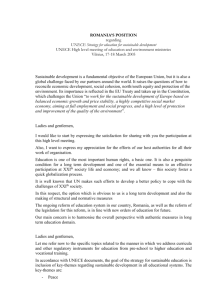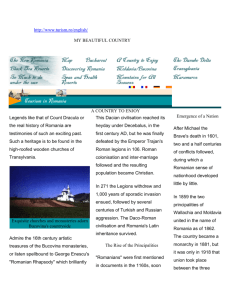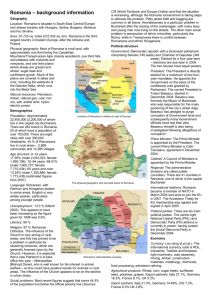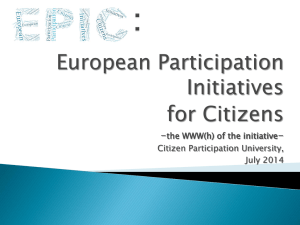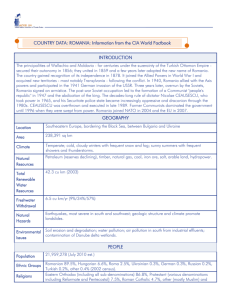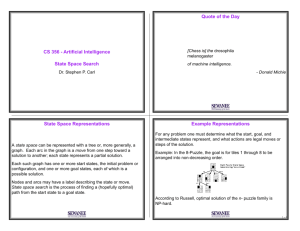Romania Country Report
advertisement
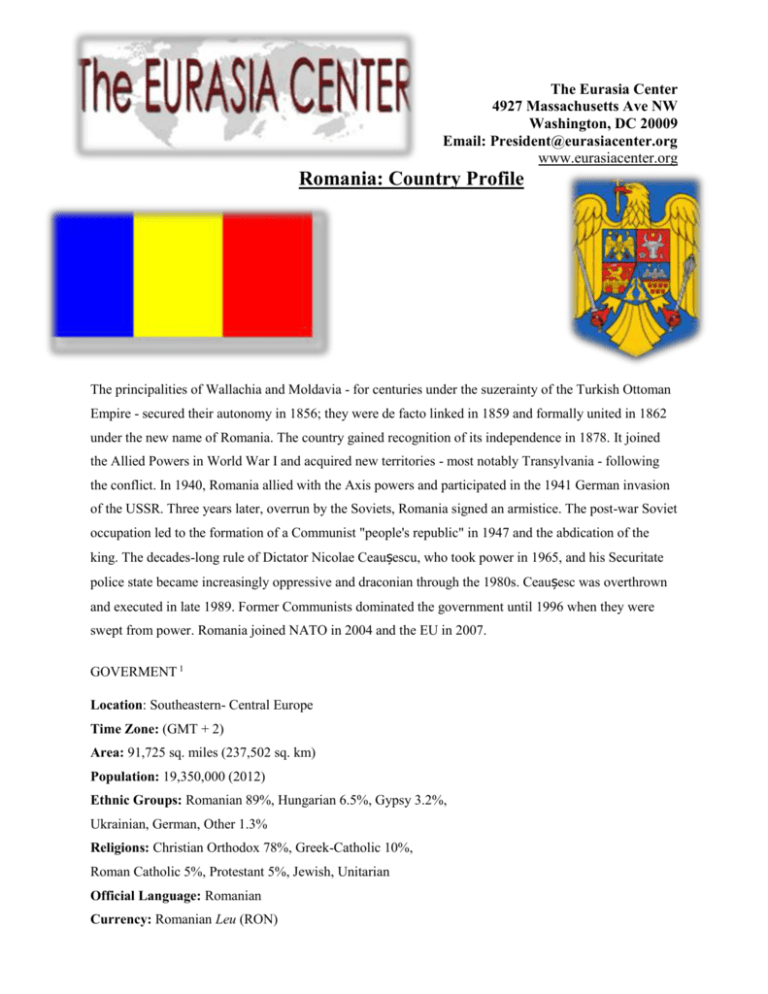
The Eurasia Center 4927 Massachusetts Ave NW Washington, DC 20009 Email: President@eurasiacenter.org www.eurasiacenter.org Romania: Country Profile The principalities of Wallachia and Moldavia - for centuries under the suzerainty of the Turkish Ottoman Empire - secured their autonomy in 1856; they were de facto linked in 1859 and formally united in 1862 under the new name of Romania. The country gained recognition of its independence in 1878. It joined the Allied Powers in World War I and acquired new territories - most notably Transylvania - following the conflict. In 1940, Romania allied with the Axis powers and participated in the 1941 German invasion of the USSR. Three years later, overrun by the Soviets, Romania signed an armistice. The post-war Soviet occupation led to the formation of a Communist "people's republic" in 1947 and the abdication of the king. The decades-long rule of Dictator Nicolae Ceaușescu, who took power in 1965, and his Securitate police state became increasingly oppressive and draconian through the 1980s. Ceaușesc was overthrown and executed in late 1989. Former Communists dominated the government until 1996 when they were swept from power. Romania joined NATO in 2004 and the EU in 2007. GOVERMENT 1 Location: Southeastern- Central Europe Time Zone: (GMT + 2) Area: 91,725 sq. miles (237,502 sq. km) Population: 19,350,000 (2012) Ethnic Groups: Romanian 89%, Hungarian 6.5%, Gypsy 3.2%, Ukrainian, German, Other 1.3% Religions: Christian Orthodox 78%, Greek-Catholic 10%, Roman Catholic 5%, Protestant 5%, Jewish, Unitarian Official Language: Romanian Currency: Romanian Leu (RON) Capital: Bucharest (București) Form of State: Semi-parliamentary Republic with two legislative bodies: Senate (Senat) and Chamber of Representatives (Camera Deputaţilor) Legal system: Based on European models and Constitution of 1991. Electoral System: Universal direct suffrage over the age of 18. Parties must win at least five percent of the national vote to gain representation in the Parliament. National Elections: November 2008; next elections: Fall 2012 (parliamentary), Fall 2014 (presidential). Head of State: President of the Republic, currently Mr. Traian Basescu National Government: The government is led by the Prime Minister, confirmed by the Parliament on the nomination of the President of Romania. The present Government is formed by the Social-Democratic Party and National-Liberal Party coalition. Head of the Government: the Prime Minister, currently Mr. Victor Ponta (Social-Democratic Party). Main political parties: Social Democratic Party (PSD), Democratic-Liberal Party (PD-L), National Liberal Party (PNL), Democratic Union of the Hungarian Minority (UDMR). Regional Government: Forty-one County Councils. Romania is a democratic republic with a market economy in which human dignity, civic rights and freedoms, the unhindered development of human personality, justice, and political pluralism are supreme and guaranteed values. Romania’s parliament has two chambers, the Senate and Chamber of Deputies. All members are elected for 4-year terms by proportional vote based on party, while the president is elected for a 5 year term (The length of the term was extended from 4 to 5 years in an October 2003 constitutional referendum). The center-right alliance of the National Liberal Party/Democratic Party and the Social Democratic Party each won roughly half of the seats in the House of Deputies in November 2004.2 A majority was created with the alliance of National Liberal Party, the Democratic Party, the Hungarian Democratic Union of Romania, the Conservative Party and ethnic minority parties. The president is elected by popular vote for a maximum of two terms. He is the head of state, charged with safeguarding the constitution, foreign affairs, and the proper functioning of public authorities. He is the commander-in-chief of the armed forces and chairman of the Supreme Defense Council. According to the constitution, he acts as mediator among the power centers within the state, as well as between the state and society. The president nominates the prime minister, who in turn appoints the government, which must be confirmed by a vote of confidence from Parliament. The Constitutional Court adjudicates the constitutionality of challenged laws and decrees. The court consists of nine judges, appointed for non-concurrent terms of 9 years. Three judges are appointed by the Chamber of Deputies, three by the Senate, and three by the president of Romania. The Romanian legal system is based on the Napoleonic Code. The judiciary is to be independent, and judges appointed by the president are not removable. The president and other judges of the High Court of Cassation and Justice are appointed for terms of 6 years and may serve consecutive terms. Proceedings are public, except in special circumstances provided for by law. Romania is divided into 41 counties and the city of Bucharest. Each county is governed by an elected county council. Local councils and elected mayors are the public administration authorities in villages and towns. The county council is the public administration authority that coordinates the activities of all village and town councils in a county. The central government appoints a representative for each county and the Bucharest municipality. The duty of the representative is to direct any public services of the ministries and other central agencies at the county level. The representative may block the action of a local authority if he deems it unlawful or unconstitutional. The matter is then decided by an administrative court. Under legislation in effect since January 1999, local councils have control over the spending of their allocations from the central government budget, as well as authority to raise additional revenue locally. ECONOMY:3 GDP (purchasing power parity): $263.9 billion (2011 est.) GDP - real growth rate: 1.5% (2011 est.) GDP - per capita (PPP): $12,300 (2011 est.) GDP - composition by sector: Agriculture: 7.9% Industry: 32.9% Services: 59.2% (2011 est.) Labor force: 9.252 million (2011 est.) Labor force - by occupation: Agriculture: 30% Industry: 20.2% Services: 49.8% (2010) Unemployment rate: 7% (2011 est.) Population below poverty line: 21.1% (2010) Distribution of family income - Gini index: 33.3 (2010) Investment (gross fixed): 23.9% of GDP (2011 est.) Budget: Revenues: $59.72 billion Expenditures: $67.56 billion (2011 est.) Romania joined the European Union on 1 January 2007 began the transition from Communism in 1989 with a largely obsolete industrial base and a pattern of output unsuited to the country's needs. The country emerged in 2000 from a punishing three-year recession thanks to strong demand in EU export markets. Domestic consumption and investment fueled strong GDP growth, but led to large current account imbalances. Romania's macroeconomic gains have only recently started to spur creation of a middle class and to address Romania's widespread poverty. Corruption and red tape continue to permeate its business environment. Inflation rose in 2007-08, driven by strong consumer demand and high wage growth, rising energy costs, a nation-wide drought, and a relaxation of fiscal discipline. As a result of the global financial crisis, Romania's GDP fell more than 7% in 2009, prompting Bucharest to seek a $26 billion emergency assistance package from the IMF, the EU, and other international lenders. Drastic austerity measures, as part of Romania's IMF-led agreement, led to a 1.3% GDP contraction in 2010. The economy returned to positive growth in 2011 due to a strong export performance, but in a deflationary environment caused by bountiful crops and weak domestic demand. In March 2011, Romania and the IMF/EC/World Bank signed a 24-month precautionary stand-by agreement, worth $4.9 billion, to promote compliance with fiscal targets, progress on structural reforms, and financial sector stability. The Romanian authorities have announced that they do not intend to draw funds from the facility. GEOGRAPHY4 Extending inland halfway across the northern limits of the Balkan Peninsula and covering a large elliptical area of 237,499 square kilometers (91,699 sq. mi.), Romania occupies the greater part of the lower basin of the Danube River system and the hilly eastern regions of the middle Danube basin. It lies on either side of the mountain systems collectively known as the Carpathians, which form the natural barrier between the two Danube basins. Romania's location gives it a continental climate, particularly in Moldavia and Wallachia (geographic areas east of the Carpathians and south of the Transylvanian Alps, respectively) and to a lesser extent in centrally located Transylvania, where the climate is more moderate. A long and at times severe winter (December-March), a hot summer (April-July), and a prolonged autumn (August-November) are the principal seasons, with a rapid transition from spring to summer. In Bucharest, the daily minimum temperature in January averages -7°C (20°F), and the daily maximum temperature in July averages 29°C (85°F). DEMOGRAPHICS5 About 89% of the people are ethnic Romanians, and as a result, the Romanian language, although containing elements of Slavic, Turkish, and other languages, is a Romance language related to French and Italian. Hungarians and Roma are the principal minorities, with a declining German population and smaller numbers of Serbs, Croats, Ukrainians, Greeks, Turks, Armenians, Great Russians, and others. Minority populations are greatest in Transylvania and the Banat. Before World War II, minorities represented more than 28% of the total population. During the war that percentage was halved, largely by the loss of the border areas of Bessarabia and northern Bukovina and southern Dobruja, as well as by the postwar flight or deportation of ethnic Germans. In the last several decades, more than two-thirds of the remaining ethnic Germans in Romania immigrated to Germany. Romanian troops during World War II participated in the destruction of the Jewish communities of Bessarabia and Transnistria and northern Bukovina. Jews in areas now comprising Romania also were subject to harsh persecution, including government-sanctioned pogroms and killings, and about 30% did not survive the Holocaust. Mass emigration, mostly to Israel, has reduced the surviving Jewish community from over 300,000 to less than 10,000. Romania's cultural traditions have been nourished by many sources, some of which predate the Roman occupation. The traditional folk arts, including dance, music, wood-carving, ceramics, weaving and embroidery of costumes and household decorations still flourish in many parts of the country. Despite strong Austrian, German, and especially French influence, many of Romania's great artists, such as the painter Nicolae Grigorescu, the poet Mihai Eminescu, the composer George Enescu, and the sculptor Constantin Brancusi, drew their inspiration from Romanian folk traditions. Romania and Moldova have a strained & complicated relationship since 1991 when Moldova became independent due to the unification movement being a major part in the Moldovan politics. Between the years of 1918–1939 most of Moldova was part of Romania. After the fall of the communist regime the two countries were not unified as many have expected but Romania still remains very interested in the affairs of Moldova. 1 http://www.romaniatourism.com/fast-facts.html 2 http://www.unpo.org/article/1567 3 https://www.cia.gov/library/publications/the-world-factbook/geos/ro.html 4 http://www.state.gov/r/pa/ei/bgn/35722.htm#geo 5 http://www.state.gov/r/pa/ei/bgn/35722.htm#people Research for this Report was done by Yafim Dorfman, research assistant, under the supervision of Dr. Gerard Janco, President, Eurasia Center/Eurasian Business Coalition.

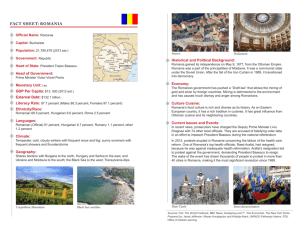
![Starbucks-Planning Bucharest June08_080630 [Compatibility Mode]](http://s3.studylib.net/store/data/008094993_1-3f54290cf0080707abba00bb3c0f92c7-300x300.png)
